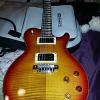Search the Community
Showing results for tags 'battery'.
-
TB516G battery usage - uses power in sleep mode ?
jeffkluth posted a topic in Relay Digital Wireless
Say do these things keep drawing power even after the light goes off ? It seems to me that they do although I havent tried any upgrades on it in a while. THanks -
Apologies for a dumb question, and yes, I did a search in the forum but can't quite find the answer I need. I've had my JTV 69 for about 3 years, haven't used it much (acoustic player, can't quite get my head around electric-but I have played on some videos I've shot and produced for non-profits) - recently got a Helix in the hope of using the two together to do some interesting things. So, I had some time over the holiday to play, went to power up my Variax, and the batteries wouldn't seem to take a charge. Ok, probably dead batteries? So I ordered a couple more batteries from Sweetwater, and the same thing. The charger just flashes its red light once a second or so. I've left them on the charger all night and no difference. And yes, I have made sure the batteries are seated well in the charger. I was trying to power up the guitar to use Workbench and to make sure I had the most up-to-date firmware for the guitar. How does the charger behave when it's charging/done charging? Is there a difference in the light pattern? I'm thinking I blew the charger - it was just left plugged in, probably since I bought it. Thanks! Larry
-
I've been working on Metallica tones for their first five albums. The goal was to get as accurate as possible. Here's where I ended up! The video quality varies quite a bit but all the guitar playing is recorded direct to the computer via USB with no mixing or any kind of extra processing added. It's straight Helix. Seek & Destroy for that gnarly, old-school metal Kill 'Em All tone Fade To Black with Hetfield's revamped and modded Marshall tone
-
Hi, I've had my G30 for almost a year. Recently I've been experiencing signal loss from the transmitter during gigs...not good. The LED's on the transmitter go off completely, and what I have to do is shake it around, press the battery door, open it, close it, whatever I have to do until eventually it comes back on again. It must be something to do with the battery compartment/connection issue. I've tried using elastic bands around it to try and keep the door firmly closed but that didn't seem to work. Everytime I've replaced batteries I have opened and closed the door the correct way by using the clip. This is really frustrating because it is happening at every gig now, and is really embarrassing especially when it happens during important guitar parts. I bought it from Thomann.de, so before I return it I want to see if people have had the same problem and if they rectified it? Or if there is something I am overlooking. Thanks, Dave.
- 2 replies
-
- g30
- transmitter
-
(and 5 more)
Tagged with:
-
Hi all, I just bought a G30 (arrives Tuesday) and in the pilot's manual it says to use alkaline over rechargeable. Why? I want to use rechargeable for obvious reasons. I gig quite a bit and would rather not have to buy 3000 batteries a year. :rolleyes: So is rechargeable AOK? Also, what is the real life expectancy of the batteries for a 4 hour night? Finally, all the talk about the battery compartment door, anything preventative I should consider? thanks!
-
I have had a G90 Relay system for about 3 years now. I recently tried to change the batteries and noticed they were not connecting properly and actually rattling around in the transmitter! The old dead batteries were not and still fit and connected well. Both Energizer brand. The old batteries are actually a millimeter or 2 longer than the new ones I had bought. Same with new Duracell's I bought. Is anyone else having this issue and is there a fix? Seems like they are making AA batteries shorter now which for spring loaded devices it's no big deal but for this transmitter its the difference between it working and not working.
-
My first post having just bought a JVT-59P (in UK). Where is the battery check button mentioned in the Pilot's Guide and on these forums? I fully charged the battery when I first got the guitar and although I have only played it for a few hours (probably in the region of 5-6 hours) the battery has just died on me suddenly today. I have it back on charge at the moment. If I was able to find the battery check button, I could monitor its discharge cycle better and not be caught out again. And before anyone asks... yes I do pull out the 1/4" cable when not playing the guitar. many thanks... Dave
-
Hey, so my DL4 cut out the other day and I've opened it up to find that batteries have exploded and leaked acid all through the pedal. The circuit is pretty burnt and it won't start at all. I've only ever run it off a line 6 official power supply. And am always super careful with the unit. Has anyone else had any problems like this? Also, being based outside of Europe, or the USA. There is no number or emailing address for me to get in contact with line 6 about the issue. If anyone could shed some light on where I can get in communication about customer support, that would be fantastic! Love the DL4, I just want to get it revived :(
- 1 reply
-
- dl4 battery acid
- broken
- (and 6 more)
-
I think I accidentally threw away the paper that came with my JTV59 about the charger. I went to charge my battery last night and wasn't sure if it was charged this morning or not. I figured the light would turn green when charged. It was blinking when it had been on steady last night. How do I know that the battery is fully charged with this charger? Thanks. Just got my JTV59 last week and this is the first time I have charged the battery.
-
I just bought a Pocket POD. I know it says not to use rechargeable batteries, but has anyone tried? Does it harm the unit? It seems to me that the only issue would be that Rechargeables have a different discharge curve than alkaline batteries, but that would at worst shorten the use between recharges. Thoughts?
-
Hello. I have a JTV89 with POD500. I have problems with the guitar when I want to use the battery. Without the battery everything works fine. With the battery I have no sound. The charge indicator indicates a full charge. I connect the guitar with different cables but nothing changes. As soon as I remove the battery, I found the sound. I tested the battery on another machine and it works. I do not know what to do ... Thank you for your help! Chris (sorry for my bad english)
-
Hi, First, let me apologize if this has been addressed elsewhere. I searched the forum for an answer to this question, but couldn't find one...hence this topic. Basically, I'm wondering if a variax 500 can be upgraded to a rechargeable lithium ion battery like the JTVs. I own a JTV 89, which I love. However, I also have an opportunity to purchase a like new variax 500 for a song. I'm thinking the current battery situation with these old variaxes are an issue. Therefore, I won't purchase this guitar unless I can ascertain whether or not the current battery set up can be converted to the new rechargeable lithium power source as with the JTVs. If this is feasible, please post any documentation, tips, tutorials, etc. Thanks so much!
- 7 replies
-
- variax 500
- battery conversion
- (and 4 more)
-
The repair shop lost the AC adapter for my JTV-69 battery charger! (In addition to only fixing the modeling section and not the magnetic pickup problems). Anyhow, does anyone know or can you put a multi-meter on the output of the AC adapter that plugs into the battery charging cradle and tell me the voltage, polarity and estimated current draw? Thanks!
-
Deutsch Français Please go through the following list before updating your James Tyler Variax guitar to flash memory v1.81 and newer from an earlier version of the flash memory to ensure the update completes successfully: Ensure that the interface you are using to update the JTV guitar with (Workbench Interface, PODxt Live/Pro, POD X3 Live/Pro, POD HD500/HD Pro, Vetta II) is NOTconnected to the computer through a USB hub. Make sure to connect the interface into a USB port directly into the computer, especially into the back of a desktop. If problems persist, make sure to test all of the USB ports on the computer. Avoid plugging into USB ports found on keyboards, monitors, or laptop docks. [*]When using the Workbench Interface to update or edit the JTV guitar, ensure that a charged battery is in the guitar and a 1/4" TS mono cable is inserted into the guitar's output jack to power on the guitar. [*]Ensure that the Volume knob on the guitar is NOT set to the '0' position as it will put the guitar into Power Save Mode. Make sure that the Volume knob is set higher than 0 when updating or editing the JTV guitar. [*]Please use the VDI Cable that comes with the JTV guitar when updating the flash memory. Avoid using VDI or CAT5 cables longer than 10 ft. in length when updating the James Tyler Variax. [*]During the update, select 'NO' when asked if you would like to keep the presets on the guitar. Use the Workbench software to back up your guitar presets before updating if you would like to keep them. [*]Close out any other applications running on your computer before updating the JTV guitar. Please use the following link for the flash memory update instructions: Variax Reflash and Software Update Instructions Checkliste für James Tyler Variax Updates: Stellen Sie sicher, dass die Schnittstelle, welche Sie zum aktualisieren Ihrer JTV benutzen (Workbench Interface, PODxt Live/Pro, POD X3 Live/Pro, POD HD500/HD Pro, Vetta II) nicht per USB Hub an Ihren Computer angeschlossen ist. Stecken Sie die Schnittstelle hinten direkt in einen der USB Ports Ihres Computers. Wenn weiterhin Probleme bestehen sollten Sie alle USB Ports ausprobieren. Achtung, vermeiden Sie es, die Schnittstelle in einen USB Port einer Tastatur, eines Monitors oder eines Laptop-Docks zu stecken. [*]Wenn Sie das Workbench Interface benutzen, um Ihre JTV zu bearbeiten oder aktualisieren, stellen Sie sicher, dass die Batterie vollgeladen und ein 6.35mm TS Mono Kabel im Gitarren Ausgangs-Jack eingesteckt ist, um die Gitarre anzuschalten. [*]Der "Volume" Knopf darf nicht auf der "0" Position sein, da die Gitarre ansonsten in den Energiesparmodus geht. Der "Volume" Knopf muss also auf einer anderen Position sein als "0" um die Aktualisierung durchzuführen. [*]Bitte benutzen Sie das VDI Kabel, welches bei der Gitarre mitgeliefert wurde wenn Sie Flash Memory aktualisieren möchten. Benutzen Sie möglichste keine CAT 5 oder VDI Kabel, die länger als 3 Meter sind wenn Sie die James Tyler Variax aktualisieren. [*]Während der Aktualisierung klicken Sie "NO" wenn Sie gefragt werden ob Sie die Presets behalten ("keep presets o nthe guitar") möchten. Sie sollten die Presets, die Sie behalten wollen vor dem Update per Workbench Software sichern. [*]Schließen Sie alle unnötigen Programme bevor Sie die JTV Gitarre aktualisieren. Bitte folgen Sie diesem Link, um Anweisungen zur Aktualisierung des Flash Memory zu erhalten: Variax Reflash and Software Update Instructions Liste de contrôle des mises à jour James Tyler Variax: Assurez-vous que l'interface pour connecter la guitare JTV à l'ordinateur (Workbench Interface, PODxt Live/Pro, POD X3 Live/Pro, POD HD500/HD Pro, Vetta II) n'est pas connectée à l'ordinateur via un hub USB. Connectez l'interface directement sur un port USB en arrière de l'ordinateur. Si vous avez des problèmes, essayez tous les ports USB de l'ordinateur. Évitez de brancher sur les ports USB sur les claviers, moniteurs ou stations d'accueil pour ordinateur portable. [*]Si vous utilisez l'interface Workbench pour mettre à jour la guitare, assurez-vous qu'une batterie chargée est dans la guitare et un câble TS mono 6.35m m est branché dans le jack de sortie de la guitare pour l'a llumer. [*]Le bouton "Volume" ne doit pas être sur la position "0" parce que ca met la guitare dans le mode économie d'énergie. Mettez-le sur une autre position que "0". [*]Veuillez utiliser le câble VDI fourni avec la guitare JTV si vous mettez le Flash Memory (firmware de la guitare) à jour. Évitez d'utiliser des câbles CAT5/VDI plus long que 3 mètres pour la mise à jour. [*]Pendant la mise à jour, cliquez sur "NO" pour la question "keep presets on the guitar". Utilisez le logiciel Workbench pour sauvegarder vos presets avant que vous mettez la firmware à jour si vous les voulez garder. [*]Fermez tous les autres programmes inutiles avant que vous mettez la JTV à jour. Utilisez le lien suivant pour les instructions de la mise à jour Flash Memory: Variax Reflash and Software Update Instructions
-
Lithium Ion (L-Ion) rechargeable batteries are a very common technology employed in many consumer electronics. The below suggested best practices and general information will help you achieve the maximum battery performance over the product’s expected lifetime. The typical estimated life of a L-Ion battery is 300-500 charge cycles (fully charged-fully discharged-fully recharged) or 2-3 years, whichever occurs first. L-Ion batteries will slowly discharge when not in use. Do not leave batteries unused for extended periods of time, neither in storage nor in the product. When a battery has been unused for 6 months, charge or dispose of the battery based on charge status. Rechargeable L-Ion batteries have a limited life and will irreversibly and gradually lose their capacity to hold a charge. Run time decreases as the battery loses capacity. Elevated temperatures can cause permanent loss capacity and negatively impacts the cycle life. Whenever possible, keep L-Ion batteries in cool conditions to preserve the capacity of the cells. For touring James Tyler Variax owners: Lithium cell and battery transportation is regulated in both the United States and the international community. When using a freight company to transport your gear, we suggest that you disclose to the freight company that your guitar has a Lithium-ion battery in it.
-

X2 Digital Wireless Power Supply and Battery FAQs
Line6Tony posted a article in Line 6 X2 Digital Wireless
Q: How much battery life should I expect with my XDR95 transmitter? A: During our in-house testing of alkaline battery performance, Kirkland, Energizer and Ray-O-Vac brands showed the best results. There are various test results available online that confirm this information. You should also be aware that there are black-market knock-offs out there that look “real†but fall short of the original manufacturer’s specifications. Line 6 digital wireless products now include Energizer batteries as others have not been performing up to spec. That being said, you should expect the battery life in the XDT4 to be between 5.5 and 6.5 Hours. Digital wireless technology has its own set of power demands, but as we develop products, we keep in mind the need for power efficiency. There is a big difference between 10 hours and 5 hours, but please remember the sound quality and benefits of the Line 6 digital system when compared to analog wireless. Q: Is the battery used in the receiver of the XDS95 overridden when using the AC adaptor input? A: In the current design, the battery is not overridden. What this means, is that if you plug in a power adapter to the XDS95 while there are working batteries in the receiver, the battery life will be drained in that configuration. Just make sure to remove the batteries if you are using a power adapter with the receiver. Q: Can I use rechargeable batteries with my Line 6 digital wireless system? A: Yes, but the specs on rechargeable batteries is all over the map and changes every time a battery is charged and discharged. In order to create and offer consistency, we have designed Line 6 digital wireless products to be used with standard 9V alkaline batteries. This way, we can predict and report battery life remaining with accuracy and translate that data to the battery meters that are included on Line 6 digital wireless components. Our knowledge of how consistently rechargeable batteries will work with the Line 6 digital wireless systems is limited. The rule of thumb is: As the battery remains above 6.2 V, it will continue to function. You may want to contact the battery manufacturer for further details. Q: What power supply should I use for the XDS-95 system? A: The Line 6 DC-1/DC1-G power supply will correctly power the XDS-95 system. Q: What power supply should I use for the XDS-plus or XDR95 system? A: the Condor 500ma power supply (supplied with the unit) or Line 6 DC1-G will power either the XDR Plus or XDR95 systems. Q: Where can I find more information on the power supply requirements and purchase a replacement/spare power supply? Power Supply, Amp Power and Battery F.A.Q. Q: Will my XDR95, XDS95 and XDSPlus work with 230/240 volt power? A: Yes, as long as the power transformer converts to 9V 500mA (For XDR95 & XDSPlus) and 9V 100mA (for XDS95) it will work. Our non-U.S. distributors sell 230V to 9V 500mA transformers. Q: I have a pedal board that distributes power to all my pedals. Can my XDS95 receiver share power with devices? A: Yes. Your XDS95 receiver only requires 9V 100mA, but the device will draw only what it needs. On pedal boards that share power with multiple devices, a device may not always get all the power that it needs. If power is being shared with other devices and you start experiencing any issues, dedicate power to the XDS95 and see if the issue goes away. -
Q: Is the Variax a MIDI guitar? A: No, the Variax is a real guitar, and the guitar does not send MIDI signals. All of the sounds available in the Variax start with the actual string vibrations of the Variax itself. Our proprietary modeling process shapes the raw string signal to replicate the sounds of the modeled instruments. Q: What type of cable can I use with the Variax? A: In order to use the supplied XPS-DI direct box/power supply to deliver power to the Variax, you will need to use the supplied 1/4-inch TRS cable or equivalent. If you use the internal batteries as your power supply, any mono 1/4-inch cable will work. Q: How do I know when it is time to change the batteries? A: When the batteries have lost their charge the indicator light will continuously flash, and the audio may become distorted or intermittent. Q: Can I use rechargeable batteries in my Variax? A: Yes, although rechargeable NiCad batteries will not last as long as alkalines, as they deliver substantially less current. Rechargeable alkaline batteries would be a longer lasting choice. Q: How long will batteries last? A: The average life of a set of 6 alkaline AA batteries should be approximately 12-14 hours. So-called 'Heavy Duty' (carbon) batteries will usually last less time. The 9-volt battery should only be used as an emergency power supply and will last approximately 1-2 hours. To help insure the longest possible battery life, be sure to unplug the 1/4 inch jack when not in use. Q: How is the Variax different from the Roland VG-8 or VG-88? A: The Variax is self-contained; all of the sounds come from inside the guitar itself. The models were specifically developed for the body resonance and transducer of the Variax for the highest possible accuracy of modeling. The VG-8/88 is an external processor that is connected to a guitar via a separate hex pickup. With the VG system, variations in tone may occur due to the guitar the pickup is attached to, and the specific placement of the pickup. The VG-8 includes basic amp modeling and effects in addition to its guitar modeling functions. With the Variax, we concentrate on the guitar characteristics only and can deliver a much higher degree of accuracy and detail. Q: Where is the Variax made? A: The Variax was designed entirely by Line 6, by experienced luthiers, engineers, and industrial designers. The Variax was originally manufactured in Korea but now is manufactured in Indonesia and China and assembled in the U.S. Our Variax guitars are made world-class facilities with the latest computer-controlled manufacturing equipment. The manufacturer prefers to remain nameless because of its relationships with other guitar companies, but they are building the guitars to Line 6's specifications. Q: Can the Variax be run through any manufacturers' effects devices? A: Yes, the Variax will work with any manufacturers' effect devices. Batteries in the Guitar will allow you to connect to Line6 and third party effects processors and wireless systems. Q: Can the Variax be used with a wireless system? My wireless transmitter does not have a TRS plug, will it still work? A: As long as you are powering the Variax with batteries, you can use a wireless like you would on a regular guitar. The TRS cable is only needed when you are using the power supply. Q: Does the Variax work with only Line 6 amps? A: The Variax works with any guitar amp from any manufacturer, but Line 6 amplifiers may have special proprietary connections for the Variax instrument. Q: Will the Ebow work on the Line 6 Variax? A: Yes, it will work fine but remember that it won't get loud over the magentic pickup because it is a piezo pickup. Q: Can I feed two amps from the jack of my Variax guitar using batteries and a y-splitter cable? A: No, the Variax jack is not a "real" stereo jack. The Variax jack does use a TRS plug, but the "sleeve" portion of it is used to transmit power rather than audio. The TRS cable is not required if you are using batteries. Q: Is there a Variax Electric reference sheet available? A: Yes there is, although not an official Line 6 document. Your collegue Line 6 enthusiasts have created several documents that will give you an overview of the models inside your Variax. You can download and print them for your own use. Download it from Vettaville and scroll down the page for the different documents Q: Is it possible to produce feedback through an amp with the Variax? A: Yes. Since the sound from the Variax starts from the strings, blasting a lot of energy into the strings by standing in front of a loud amp will produce feedback. And since the Variax uses a piezo bridge instead of conventional magnetic pickups, you won't get microphonic squeals.




